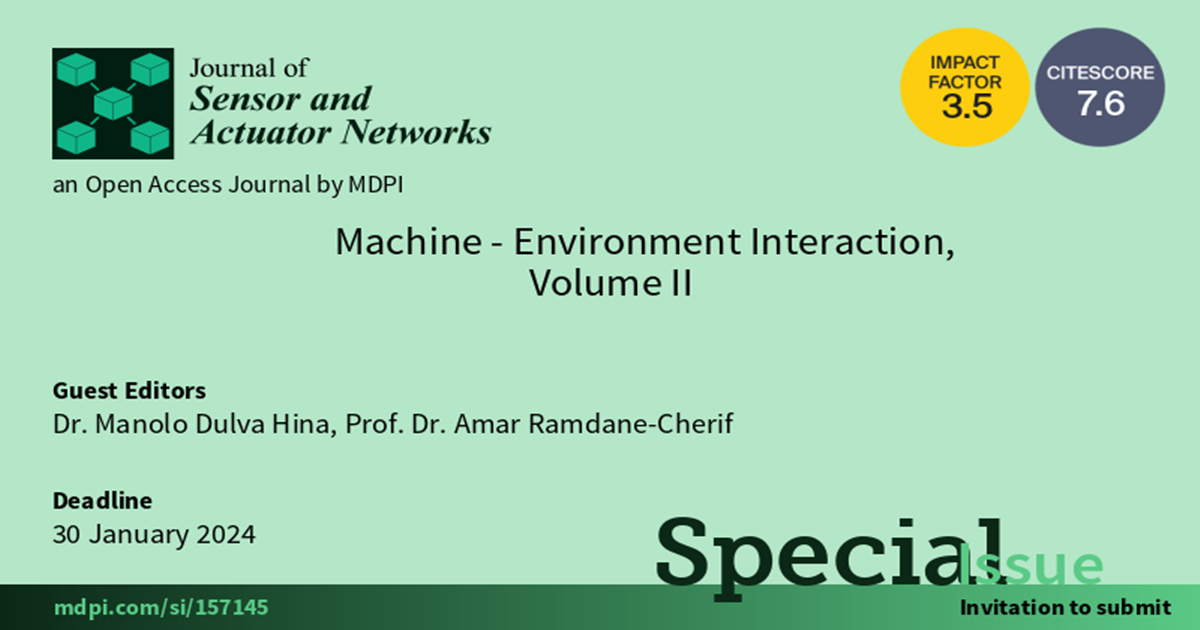Machine-Environment Interaction, Volume II
A special issue of Journal of Sensor and Actuator Networks (ISSN 2224-2708). This special issue belongs to the section "Big Data, Computing and Artificial Intelligence".
Deadline for manuscript submissions: closed (30 January 2024) | Viewed by 8087

Special Issue Editors
Interests: knowledge representation; machine learning; computational intelligence; artificial intelligence; formal methods; multimodal computing
Special Issues, Collections and Topics in MDPI journals
Interests: software architecture; dynamic architecture; knowledge representation and reasoning; interaction machine-environment; ambient intelligence; robotic interaction; data fusion and fission; embedded system
Special Issue Information
Dear Colleagues,
Machine–environment interaction is a vast and complex domain located at the crossroads of several artificial intelligence disciplines, the representation of knowledge and reasoning, ambient intelligence, networks of sensors, etc.
An intelligent machine (robot, vehicle, drone, etc.) can evolve in a so-called “smart” environment (smart home, smart city, etc.). Such a connected environment has a network of sensors that an intelligent machine can use in addition to its own sensors to better understand the environment and interact with the objects that are present there. Humans are a part of this environment, and hence, human–machine integration is a special case of machine–environment interaction.
The interaction loop between machine and environment is made up of the following processes: perception, comprehension, decision, and action. Thus, an intelligent machine has the capacity to perceive the environment, understand its current state, make decisions, and act on the environment to execute decisions.
Research and development in interactive systems entails many challenges and opportunities, not only in hardware and software but also on various sensors, which constitute important tools of these systems to perceive the environment.
We would like to draw your attention to the JSAN Special Issue on “Machine–Environment Interaction”. Extended versions of selected papers from the 3rd EAI International Conference on Computational Intelligence and Communications (CICom 2022), to be held in Australia on 28–29 December 2022 (https://cicom-conference.eai-conferences.org/2022/), will be considered for this Special Issue. In addition, we invite other researchers beyond CICom 2022 to submit papers on a topic within the field of machine–environment interaction, including its related fields which may include but are not limited to the following areas:
- Representation of the environment of an interactive system: models, formalisms;
- The perception of the environment of interactive systems;
- Data fusion and fission in interactive systems;
- Techniques and methods for optimization and learning to facilitate interaction;
- Reasoning in decision-making components of interactive systems;
- System for evaluation and analysis of interactive systems;
- Networks of sensors for interactive systems.
Dr. Manolo Dulva Hina
Prof. Dr. Amar Ramdane-Cherif
Guest Editors
Manuscript Submission Information
Manuscripts should be submitted online at www.mdpi.com by registering and logging in to this website. Once you are registered, click here to go to the submission form. Manuscripts can be submitted until the deadline. All submissions that pass pre-check are peer-reviewed. Accepted papers will be published continuously in the journal (as soon as accepted) and will be listed together on the special issue website. Research articles, review articles as well as short communications are invited. For planned papers, a title and short abstract (about 100 words) can be sent to the Editorial Office for announcement on this website.
Submitted manuscripts should not have been published previously, nor be under consideration for publication elsewhere (except conference proceedings papers). All manuscripts are thoroughly refereed through a single-blind peer-review process. A guide for authors and other relevant information for submission of manuscripts is available on the Instructions for Authors page. Journal of Sensor and Actuator Networks is an international peer-reviewed open access semimonthly journal published by MDPI.
Please visit the Instructions for Authors page before submitting a manuscript. The Article Processing Charge (APC) for publication in this open access journal is 2000 CHF (Swiss Francs). Submitted papers should be well formatted and use good English. Authors may use MDPI's English editing service prior to publication or during author revisions.






